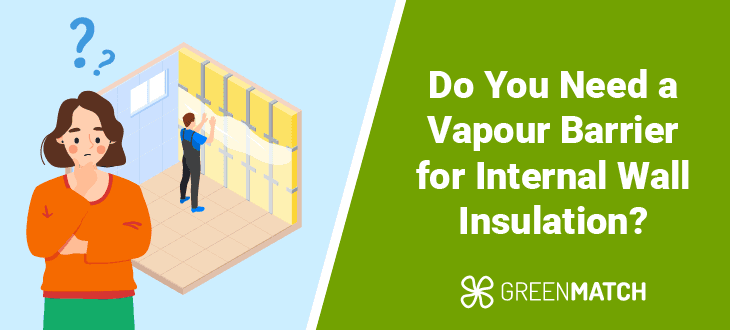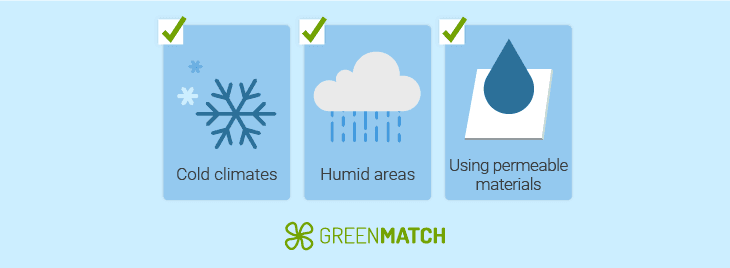Answer these simple questions and we will find you the BEST prices
Which type of solar quotes do you need?
It only takes 30 seconds
100% free with no obligation

Get Free quotes from insulation specialists near you

Save money by comparing quotes and choosing the most competitive offer

The service is 100% free and with no obligation
- GreenMatch
- Insulation
- Wall Insulation
- Internal Wall Insulation
- Vapour Barrier for Internal Walls
Do You Need a Vapour Barrier for Internal Wall Insulation?


- Vapour barriers prevent moisture buildup in insulation, avoiding mould, reduced insulation performance, and structural damage, especially in cold or humid conditions.
- The need for a vapour barrier depends on your climate, insulation type, and property conditions; consult a professional for guidance.
- In breathable walls or warm, humid climates, vapour-permeable membranes offer better moisture control and prevent condensation.
Poorly insulated walls are one of the main culprits of home heat loss, allowing up to 35% of indoor warmth to escape through unprotected surfaces. In the UK, where over 21 million homes lack sufficient insulation, this problem drives up energy bills. It contributes significantly to the nation's carbon emissions. Domestic energy consumption alone accounts for 27% of the UK's total carbon footprint.
Internal wall insulation offers an effective and practical solution for those looking to tackle this issue. It is particularly beneficial for homes with solid walls or properties where exterior modifications, such as listed or historic buildings, aren't an option. Beyond its ability to retain heat, internal wall insulation can also lead to substantial savings—potentially reducing annual energy costs by £140 to £700 while cutting carbon emissions by up to 2,100 kg of CO2.
Yet, an important consideration arises during installation: is a vapour barrier necessary? Vapour barriers prevent moisture buildup in insulation, which can otherwise lead to mould, compromised performance, and damage to the building structure. Whether or not a vapour barrier is needed depends on factors such as the type of insulation, the climate, and the property's specific conditions.
This guide examines the role of vapour barriers in internal wall insulation, discussing when they are required, their benefits, and their impact on insulation efficiency. By the end, you'll have the insights to make an informed choice for a more energy-efficient and comfortable home.
Consulting a professional is the best way to determine if you need a vapour barrier. GreenMatch simplifies finding the right insulation installer by offering up to four free quotes from trusted specialists in your area. Fill out our quick 30-second form to get started—no hassle, no obligations. Click below to learn more.
- Describe your needs
- Get free quotes
- Choose the best offer
It only takes 30 seconds



Is a vapour barrier needed for insulating internal walls?

Determining whether to use a vapour barrier ensures the insulation’s effectiveness and longevity when insulating walls. The need for a vapour barrier depends on factors such as wall construction, climate, and the materials used.
Vapour barriers prevent moisture from penetrating walls and reaching the insulation, which could condense and cause mould, mildew, and structural damage. They are particularly beneficial when insulating walls in situations with high moisture levels, such as bathrooms or kitchens, in colder climates where condensation is likely, or in walls constructed with materials prone to moisture damage.
When conditions warrant their use, vapour barriers offer several advantages:
- Condensation prevention: Vapour barriers reduce the risk of condensation by blocking moist air from reaching the insulation, preserving the insulation’s effectiveness and preventing mould growth.
- Enhanced durability: They protect insulation and structural components, helping maintain their integrity over time.
- Improved thermal efficiency: Dry insulation performs better than damp insulation, resulting in greater energy efficiency and lower heating costs.
- Cost savings: Preventing moisture-related damage minimises repair expenses in the long run.
However, vapour barriers are not universally necessary and, in some cases, can be counterproductive. Walls with breathable materials, such as lime plaster or eco-friendly insulations like sheep’s wool or hemp, naturally regulate moisture. Adding a vapour barrier when insulating walls in these situations can trap moisture and lead to issues.
Similarly, vapour barriers may hinder moisture escape in warm, humid climates, exacerbating problems. Modern vapour-permeable membranes, which allow controlled moisture movement while protecting against condensation, often offer a more flexible alternative to traditional vapour barriers.
Ultimately, the decision to use a vapour barrier when insulating walls depends on the specific circumstances of the building and the environment. Thoughtful consideration of materials and climate and professional advice can help strike the right balance between moisture control and wall breathability.
When should you install a vapour barrier for internal wall insulation?

A vapour barrier is critical for ensuring the effectiveness and durability of internal wall insulation in certain conditions. It prevents moisture from penetrating the insulation, reducing the risk of condensation, mould growth, and structural damage. Here are some scenarios where installing a vapour barrier is recommended:
- Cold climates: In cold climates, warm indoor air carrying moisture can pass through walls and condense on colder surfaces. A vapour barrier, installed on the warm side of the insulation, helps prevent this condensation and protects the insulation and the wall structure.
- Humid areas: Rooms with high humidity levels, such as bathrooms, kitchens, or laundry rooms, are more prone to moisture buildup. A vapour barrier can prevent moisture from seeping into the walls, ensuring the insulation remains dry and effective.
- Using permeable materials: Insulations like fibreglass, mineral wool, or other moisture-permeable materials are susceptible to water damage if exposed to high moisture levels. A vapour barrier helps shield these types of insulation from moisture ingress, improving their performance and lifespan.
If your insulation requires a vapour barrier to prevent moisture build-up in your home, it’s crucial to position it on the warm side of the insulation. This placement helps stop condensation from forming within the wall or ceiling cavities, ensuring effective moisture protection.
- Avoid vapour barriers made of breathable materials like lime plaster, sheep’s wool, or hemp insulation, as these materials rely on natural moisture regulation.
- Vapour barriers can trap moisture and worsen condensation issues in warm, humid climates.
- Use vapour-permeable membranes as an alternative in situations requiring controlled moisture movement.
How to install a vapour barrier for internal wall insulation
Proper vapour barrier installation is crucial for effective internal wall insulation, as it prevents moisture from compromising the insulation and structural integrity. While the process can be complex, involving precise measurements and specialised tools, it is advisable to consult with a professional to ensure optimal results. A general overview of the installation steps includes:
- Measuring and cutting insulation: Accurately measure the wall dimensions and cut the insulation material to fit snugly between the wall studs.
- Installing stud wall insulation: Place the cut insulation between the studs, ensuring it fits tightly without gaps.
- Applying sealing tape: Attach sealing tape to the studs to prevent the vapour barrier from tearing during installation and inhibit moisture transfer at fastening points.
- Installing the vapour barrier: Drape the vapour barrier over the insulation and secure it to the studs using appropriate fasteners, such as staples.
- Sealing edges and joints: Use double-sided, airtight adhesive tape to seal the vapour barrier's overlaps and edges, ensuring an airtight seal.
- Securing to adjacent surfaces: Apply sealant adhesive to adjacent walls or ceilings and affix the vapour barrier to these surfaces, trimming any excess material.
- Preparing for wall cladding: Install a substructure, such as a plasterboard, over the vapour barrier to prepare for the final wall cladding.
Given the technical nature of these steps and the importance of a proper seal to prevent moisture issues, it is recommended that you engage a professional with experience in vapour barrier installation. This ensures the insulation system functions effectively and maintains the building's integrity over time.
Finding the right internal wall insulation installers to suit your needs can be challenging, often involving comparing multiple quotes without clear direction. Fortunately, GreenMatch makes this process easier. By completing our quick 30-second form, you can receive up to four free quotes from top-rated insulation installers in your area. Click below to get started!
- Describe your needs
- Get free quotes
- Choose the best offer
It only takes 30 seconds



How much does a vapour barrier cost?

On average, internal wall insulation costs between £40 and £50 per square metre, while vapour barriers generally cost around £2.25 per square metre. However, the price of a vapour barrier may increase based on its thickness, the manufacturer, and the size needed for your project.
- Material type and thickness: Thicker, more durable materials offer better protection but tend to be more expensive. For example, polyethene vapour barriers are cost-effective. In contrast, foil-faced barriers, which provide additional benefits such as radiant heat reflection, are more expensive.
- Installation complexity: If the walls have intricate designs or hard-to-reach areas, additional labour may be required, raising the overall cost.
- Labour costs: Professional installation expenses vary by location and project complexity. Obtaining multiple quotes ensures you receive competitive pricing.
- Additional materials: Accessories such as sealants, tapes, and adhesives necessary for proper installation can also contribute to the total expense.
Investing in a high-quality vapour barrier is crucial for protecting your home from moisture-related issues and ensuring the long-term performance of your insulation. Working with experienced professionals ensures that your internal wall insulation and vapour barrier are installed correctly, preventing potential problems down the line.
At GreenMatch, we simplify finding the best insulation installers in your area. We provide up to four free quotes from top-rated professionals—no hidden costs, no obligations. Fill out our quick 30-second form to get started. Click below to learn more and take the first step toward better insulation for your home.
- Describe your needs
- Get free quotes
- Choose the best offer
It only takes 30 seconds



FAQ
Use a vapour barrier with insulation in cold climates, high-humidity areas, or when using permeable insulation materials to prevent moisture build-up and condensation.
You need a vapour barrier for internal wall insulation in cold climates, high-moisture areas, or with permeable insulation materials, but it depends on your property’s specific conditions.
The vapour barrier should be installed on the warm side of the insulation to prevent moisture from condensing within the wall or ceiling cavities.

Caoimhe is an experienced content writer and researcher who is passionate about providing accessible information to every reader. With a background in English literature and Sociology, she combines the two disciplines to create cohesive, well-thought-out, and well-informed pieces.
We strive to connect our customers with the right product and supplier. Would you like to be part of GreenMatch?

- Describe your needs
- Get free quotes
- Choose the best offer
It only takes 30 seconds



